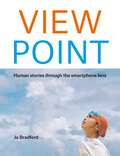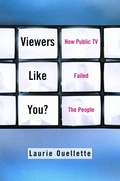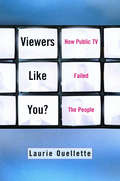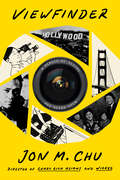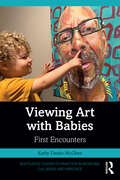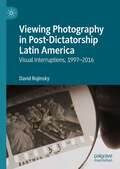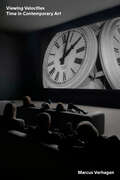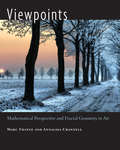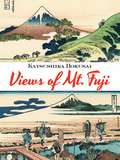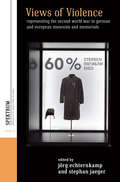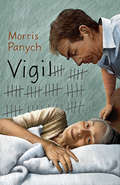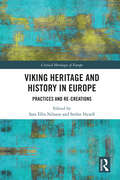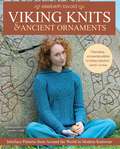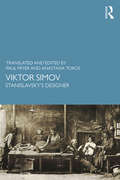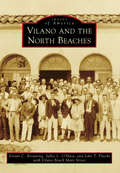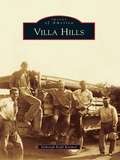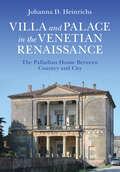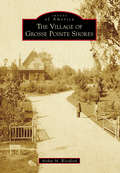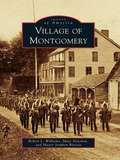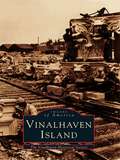- Table View
- List View
ViewPoint: Human stories through the smartphone lens
by Jo BradfordInternational in scope and full of beautiful and impactful imagery that highlights the immediacy of the genre, View/Point is a book of human experience stories as told through the medium of phone photography. Featuring more than 50 contributors from every corner of the globe, interviewed by the author about their lives and their photographic art, this book offers a definitive take on both the power of the still image to tell a story and the joy of personal expression that phone photography offers.
Viewers Like You: How Public TV Failed the People
by Laurie OuelletteHow "public" is public television if only a small percentage of the American people tune in on a regular basis? When public television addresses "viewers like you," just who are you? Despite the current of frustration with commercial television that runs through American life, most TV viewers bypass the redemptive "oasis of the wasteland" represented by PBS and turn to the sitcoms, soap operas, music videos, game shows, weekly dramas, and popular news programs produced by the culture industries. Viewers Like You? traces the history of public broadcasting in the United States, questions its priorities, and argues that public TV's tendency to reject popular culture has undermined its capacity to serve the people it claims to represent. Drawing from archival research and cultural theory, the book shows that public television's perception of what the public needs is constrained by unquestioned cultural assumptions rooted in the politics of class, gender, and race.
Viewers Like You: How Public TV Failed the People
by Laurie OulletteHow "public" is public television if only a small percentage of the American people tune in on a regular basis? When public television addresses "viewers like you," just who are you? Despite the current of frustration with commercial television that runs through American life, most TV viewers bypass the redemptive "oasis of the wasteland" represented by PBS and turn to the sitcoms, soap operas, music videos, game shows, weekly dramas, and popular news programs produced by the culture industries. Viewers Like You? traces the history of public broadcasting in the United States, questions its priorities, and argues that public TV's tendency to reject popular culture has undermined its capacity to serve the people it claims to represent. Drawing from archival research and cultural theory, the book shows that public television's perception of what the public needs is constrained by unquestioned cultural assumptions rooted in the politics of class, gender, and race.
Viewfinder: A Memoir of Seeing and Being Seen
by Jeremy McCarter Jon M. ChuFrom visionary director Jon M. Chu comes a powerful, inspiring memoir of belonging, creativity, and learning to see who you really are.&“A must-read for aspiring artists and dreamers of all kinds.&”—Ava DuVernayLong before he directed Wicked, In The Heights, or the groundbreaking film Crazy Rich Asians, Jon M. Chu was a movie-obsessed first-generation Chinese American, helping at his parents&’ Chinese restaurant in Silicon Valley and forever facing the cultural identity crisis endemic to children of immigrants. Growing up on the cutting edge of twenty-first-century technology gave Chu the tools he needed to make his mark at USC film school, and to be discovered by Steven Spielberg, but he soon found himself struggling to understand who he was. In this book, for the first time, Chu turns the lens on his own life and work, telling the universal story of questioning what it means when your dreams collide with your circumstances, and showing how it&’s possible to succeed even when the world changes beyond all recognition. With striking candor and unrivaled insights, Chu offers a firsthand account of the collision of Silicon Valley and Hollywood—what it&’s been like to watch his old world shatter and reshape his new one. Ultimately, Viewfinder is about reckoning with your own story, becoming your most creative self, and finding a path all your own.
Viewing America
by Christopher BigsbySomething has happened in the world of television drama. For the last decade and a half America has assumed a dominant position. Novelists, screenwriters and journalists, who would once have had no interest in writing for television, indeed who often despised it, suddenly realised that it was where America could have a dialogue with itself. The new television drama was where writers could engage with the social and political realities of the time, interrogating the myths and values of a society moving into a new century. Familiar genres have been reinvented, from crime fiction to science fiction. This is a book as much about a changing America as about the television series which have addressed it, from The Sopranos and The Wire to The West Wing, Mad Men and Treme, in what has emerged as the second golden age of American television drama.
Viewing Art with Babies: First Encounters (Routledge Guides to Practice in Museums, Galleries and Heritage)
by Kathy Danko-McGheeViewing Art with Babies demonstrates how to facilitate quality art viewing experiences with babies from as young as 2 months old. Such experiences can help to nurture early literacy and receptive language skills, sensory stimulation, and early brain development. Based on the author’s research with babies in New Zealand, Australia, Romania, England, and the U.S., the book provides the reader with information about early brain, vision, sensory and language development, and the aesthetic preferences of babies. Danko-McGhee provides details about the type of art that babies like, how to display art in the learning environment, and how to interact with a baby when viewing art. Case studies of international museums, national museums, and community agencies that have had success with engaging babies in art viewing experiences have been included in the book as a way of demonstrating how theory and research can be successfully put into practice. Viewing Art with Babies details practical ways through which museum practitioners, early childhood and community educators, and parents can provide artviewing experiences in the museum, early childhood classroom or even their own home. It will be of interest to practitioners and parents around the world, and those engaged in the study of museum education.
Viewing Inscriptions in the Late Antique and Medieval World
by Antony EastmondInscriptions convey meaning not just by their contents but also by other means, such as choice of script, location, scale, spatial organisation, letterform, legibility and clarity. The essays in this book consider these visual qualities of inscriptions, ranging across the Mediterranean and the Near East from Spain to Iran and beyond, including Norman Sicily, Islamic North Africa, Byzantium, medieval Italy, Georgia and Armenia. While most essays focus on Late Antiquity and the Middle Ages, they also look back at Achaemenid Iran and forward to Mughal India. Topics discussed include real and pseudo-writing, multilingual inscriptions, graffiti, writing disguised as images and images disguised as words. From public texts set up on mountainsides or on church and madrasa walls to intimate craftsmen's signatures, barely visible on the undersides of precious objects, the inscriptions discussed in this volume reveal their meanings as textual and visual devices.
Viewing Photography in Post-Dictatorship Latin America: Visual Interruptions, 1997-2016
by David RojinskyThis book examines the archival aesthetic of mourning and memory developed by Latin American artists and photographers between 1997-2016. Particular attention is paid to how photographs of the assassinated or disappeared political dissident of the 1970s and 1980s, as found in family albums and in official archives, were not only re-imagined as conduits for private mourning, but also became allegories of social trauma and the struggle against socio-political amnesia. Memorials, art installations, photo-essays, street projections, and documentary films are all considered as media for the reframing of these archival images from the era of the Cold War dictatorships in Argentina, Chile, Guatemala, and Uruguay. While the turn of the millennium was supposedly marked by “the end of history” and, with the advent of digital technologies, by “the end of photography,” these works served to interrupt and hence, belie the dominant narrative on both counts. Indeed, the book's overarching contention is that the viewer’s affective identification with distant suffering when engaging these artworks is equally interrupted: instead, the viewer is invited to apprehend memorial images as emblems of national and international histories of ideological struggle.
Viewing Velocities: Time in Contemporary Art
by Marcus VerhagenContemporary art and the culture of speedHow have artists responded to our market-driven, tech-enabled culture of speed? Viewing Velocities explores a contemporary art scene caught in the gears of 24/7 capitalism. It looks at artists who embrace the high-octane experience economy and others who are closer to the slow movement. Some of the most compelling artworks addressing the cadences of contemporary work and leisure play on distinct, even contradictory conceptions of time. From Danh Vo's relics to Moyra Davey's photographs of dust-covered belongings, from Roman Ondak's queuing performers and Susan Hiller's outdoor sleepers to Maria Eichhorn's art strike and Ruth Ewan's giant reconstruction of the French revolutionary calendar, artists have drawn out aspects of the present temporal order that are familiar to the point of near-invisibility, while outlining other, more liberating ways of conceiving, organising and experiencing time.Marcus Verhagen builds on the work of theorists Jonathan Crary, Hartmut Rosa and Jacques Rancière to trace lines of insurgent art that recast struggles over time and history in novel and revealing terms.
Viewpoints: Mathematical Perspective and Fractal Geometry in Art
by Annalisa Crannell Marc FrantzAn undergraduate textbook devoted exclusively to relationships between mathematics and art, Viewpoints is ideally suited for math-for-liberal-arts courses and mathematics courses for fine arts majors. The textbook contains a wide variety of classroom-tested activities and problems, a series of essays by contemporary artists written especially for the book, and a plethora of pedagogical and learning opportunities for instructors and students. Viewpoints focuses on two mathematical areas: perspective related to drawing man-made forms and fractal geometry related to drawing natural forms. Investigating facets of the three-dimensional world in order to understand mathematical concepts behind the art, the textbook explores art topics including comic, anamorphic, and classical art, as well as photography, while presenting such mathematical ideas as proportion, ratio, self-similarity, exponents, and logarithms. Straightforward problems and rewarding solutions empower students to make accurate, sophisticated drawings. Personal essays and short biographies by contemporary artists are interspersed between chapters and are accompanied by images of their work. These fine artists--who include mathematicians and scientists--examine how mathematics influences their art. Accessible to students of all levels, Viewpoints encourages experimentation and collaboration, and captures the essence of artistic and mathematical creation and discovery. Classroom-tested activities and problem solving Accessible problems that move beyond regular art school curriculum Multiple solutions of varying difficulty and applicability Appropriate for students of all mathematics and art levels Original and exclusive essays by contemporary artists Forthcoming: Instructor's manual (available only to teachers)
Views of Mt. Fuji: One Hundred Views Of Mt. Fuji
by Katsushika HokusaiKatsushika Hokusai was among the foremost ukiyo-e artists of his generation, and his Thirty-six Views of Mt. Fuji ranks among the best-known series of Japanese woodblock prints. This edition presents a full-color reprint of that enduring masterpiece, plus the artist's later black-and-white series, One Hundred Views of Mt. Fuji. A must for all lovers of Japanese art.
Views of Violence: Representing the Second World War in German and European Museums and Memorials (Spektrum: Publications of the German Studies Association #19)
by Jörg Echternkamp Stephan JaegerTwenty-first-century views of historical violence have been immeasurably influenced by cultural representations of the Second World War. Within Europe, one of the key sites for such representation has been the vast array of museums and memorials that reflect contemporary ideas of war, the roles of soldiers and civilians, and the self-perception of those who remember. This volume takes a historical perspective on museums covering the Second World War and explores how these institutions came to define political contexts and cultures of public memory in Germany, across Europe, and throughout the world.
Vigil
by Morris PanychA man returns after thirty years to sit with a relative on her deathbed. Kemp's problem is: she's not dying fast enough. Through Kemp's own errors and inattentiveness, the visit that he thinks will take a day or two stretches into a year. A play of mistaken identity, twisted circumstance, and surprising turns, this is one Vigil worth keeping.
Viking Art (World of Art)
by James Graham-CampbellThe Viking Age in Europe lasted from the time of the first major Viking expeditions in 800 CE to the widespread adoption of Christianity in Scandinavia some 300 years later. During that time, Viking art and culture spread across continental Europe and into the world beyond. Written by a leading authority on the subject, this book introduces readers to the intricate objects and beautiful art styles that developed during the Viking Age.
Viking Heritage and History in Europe: Practices and Re-creations (Critical Heritages of Europe)
by Stefan Nyzell Sara Ellis NilssonViking Heritage and History in Europe presents new research and perspectives on the use of the Vikings in public history, especially in relation to museums, re-creation, and re-enactment in a European context.Taking a critical heritage approach, the volume provides new insights into the re-creation of history, imagining the past, interpretation, ambivalence of authenticity, authority of History, remembrance and memory, medievalism, and public history. Highlighting the complexity of the field of public history today, the fourteen chapters all engage with questions of historical authenticity and authority. The volume also critically examines the public’s reception, engagement with, and interpretation of the Viking Age and the concepts of who these individuals were. Each chapter illuminates an aspect of these themes in relation to museums, leisure activities, politics, tourism, re-enactment, and popular culture – all from the vantage point of Viking cultural heritage.Viking Heritage and History in Europe is one of the first volumes to examine the use and role of the Vikings within the field of public history, both past and present. The book will be of interest to those engaged in the study of heritage, public history, history, the Vikings, vikingism, medievalism, and media history.
Viking Knits and Ancient Ornaments
by Elsebeth LavoldEver since her ground-breaking bookViking Patterns for Knittingwas published, Elsebeth Lavold has been recognized as one of the world's leading experts on cabling. In the book, described as an indispensable milestone in 20th century knitting literature, she introduces her own innovation, using lifted increases to create interlace patterns instead of just to shape garments, and to bring new life to the ornamental heritage of the Vikings as adornment on modern knitwear.With more than a decade of added experience and continued research, she took the concept a step further. Still firmly based in her Scandinavian roots, she has studied cultures from all over the globe to find similar types of patterns. This resulted in a fascinating compilation of ornamental expressions, ancient as well as contemporary, and just as inViking Patterns for Knittingshe uses them as a launch pad for her own unique designs.Elsebeth genuinely enjoys sharing her knowledge. In addition to the abundance of beautiful garments presented in the book with complete instructions, she has analyzed a huge number of pattern types and displays them in both swatch and chart form, to allow you to make your own designs based on her research.Pattern corrections
Viktor Simov: Stanislavsky’s Designer
by Paul Fryer Anastasia TorosViktor Simov is the first English-language biography of Konstantin Stanislavsky’s principal scenic designer at the Moscow Art Theatre from the company’s formation in 1898. His ground-breaking work included the designs for the premieres of Anton Chekhov’s major stage plays, and his approach to theatre design still influences contemporary scenography. Translated from the original Russian text written by author, editor, and literary critic Yuri Ivanovich Nekhoroshev, the book provides a revealing insight into the staging and technical practices of one of the world’s most influential theatre companies. Supported by 60 illustrations representing the full range of Simov’s designs, this volume provides a historical account of Simov’s career and a vivid description and critical assessment of his work. The book traces the artist’s development from his early years as a painter to his later experiments in early silent film design, including his work for the classic Russian science fiction film Aelita, Queen of Mars (1924). Written for theatre scholars and students of Scenic Design and Drama courses, Viktor Simov: Stanislavsky’s designer re-establishes Simov as one of the most influential theatre designers of the 20th century.
Vilano and the North Beaches
by John T. Pilecki Sallie L. O’hara Vilano Beach Main Street Vivian C. BrowningVilano and the North Beaches are perhaps most known as small, eclectic beach communities within sight of St. Augustine, the nation's oldest city. For centuries, people have flocked to this coastal playground by horse-drawn trolley, ferry, and more recently Florida's Coastal Highway, State Road A1A. They came for recreation, jobs, and sunny weather in the late 1800s, when Henry Flagler attracted Northerners to his "new and novel" hotels. Visitors were excited to learn the ocean was just across the bay. Tourism provided jobs for settlers, like the Minorcan, Usina, and Capo families, offering fun excursions. Nowhere else were horse-drawn trolleys delivering beachgoers across sand dunes to the sea. Like Ponce de León, who was smitten with the pristine beaches, the area's story is one of developing the land along an isolated coastline. Road and bridge construction after World War II encouraged migration as well as visitors to the beaches, fish camps, and Art Deco motor courts. This nostalgic 1950s look remains today, attracting those curious about the region's multicultural history.
Villa Hills (Images of America)
by Deborah Kohl KremerAlthough the small town of Villa Hills was incorporated into a sixth-class city in 1962, the area where the city sits was home to luscious farmland dating back to the time when Kentucky was still part of Virginia. The development of Villa Hills is the story of the birth of a suburb. It is the perfect example of population sprawling away from the larger cities, as people looked for a more rural setting to raise their families. In the late 1950s, what they found was unincorporated Kenton County, bounded by the tiny town of Crescent Springs and the Ohio River. At this pivotal time in the area's history, farmers were beginning to sell their land and builders were breaking ground on three-bedroom ranch homes and four-bedroom two stories. Images of America: Villa Hills presents the history of the farmers who worked the land, the Benedictine sisters who established a monastery, and the young families who worked together to build the city now known as Villa Hills.
Villa and Palace in the Venetian Renaissance: The Palladian House Between Country and City
by Johanna D. HeinrichsDesigned by Andrea Palladio, the Villa Pisani at Montagnana was the country residence of a Venetian nobleman, Francesco Pisani. Unusually, its design combines features of both villa and palace architecture, and it challenges the conventional view of a villa as subsidiary to the urban palace, the true seat of an elite family. In this book, Johanna D. Heinrichs offers the first comprehensive study of the Villa Pisani, providing a critical analysis of Palladio's hybrid design, the villa's original setting and uses, and the preoccupations of its patron. Heinrichs argues that the Villa Pisani served as the owner's principal residence. She also shows how a microhistorical approach can provide new insights about a familiar Renaissance building type and about the theory and practice of a canonical architect. Based on scrutiny of original documents and visual sources, Heinrichs's study is supported by a rich illustration program composed of photographs, plans, maps, and digital reconstructions.
Village of Grosse Pointe Shores, The
by Arthur M. WoodfordThe Village of Grosse Pointe Shores, nestled along the shore of Lake St. Clair just north of Detroit, is the smallest of the five Grosse Pointe communities. After the settlement of Detroit in 1701, the area that would become Grosse Pointe Shores saw the arrival of French habitants who built their ribbon farms. Beginning in the 1860s, the area began to change as well-to-do Detroiters erected summer homes on the lakeshore. The Village of Grosse Pointe Shores was formally established in 1911, and the community grew as great mansions were built along Lake Shore Road. Following World War II, the community evolved yet again as the grand mansions disappeared and properties were subdivided. By the end of the 20th century, the village had grown into an established community of comfortable, well-maintained homes. In 2011, these residents gathered together to celebrate the 100th anniversary of their community.
Village of Montgomery (Images of America)
by Robert L. Williams Marc Newman Mayor Stephen BresciaNoted for its picturesque historic districts and venerable homes, the village of Montgomery is nestled into northern Orange County, bounded by the Wallkill River in the shadow of the Comfort Hills. Filled with rare photographs dating from the 1870s to the present, Village of Montgomery focuses on the history of the hamlet and its churches, roads, businesses, schools, and cemeteries, providing insight into how village residents lived, worked, and played in years past. The insightful text accompanying each photograph reveals intriguing and little-known facts about the village and its people.
Villager Jim's Bobbin Robin
by Villager JimOver many years, Villager Jim has gained the trust of a number of special birds and animals who have gradually taken it as second nature that a member of their own small world is a large chap with a camera!Bobbin Robin and her friends have a huge social media audience, with tens of thousands of viewers following her weekly adventures from the RSPB and on Facebook.Bobbin the robin has now become rather adept at posing for Jim, perching on various platforms for wherever Jim sits in his garden.Open up the book to see the daily goings-on of these wildlife friends in some of Jims very best pictures taken in this beautiful setting. They illustrate the close relationship Jim has formed with Bobbin and her friends.Jims lively captions express the mood and spontaneous character of each individual shot and are an essential element of what makes his pictures so special.
Villager Jim's Highland Cows
by Villager JimHugely charismatic, the Highland cattle breed is the focus of this photographic tribute to one of Britains most popular farm animals. These long-horned, curly coated cows are amongst the many now famous subjects featured in Villager Jims daily online photographic adventures, which have gained nearly 200,000 followers.Jim often wanders amongst the herds throughout the seasons, taking shots from many different angles as they graze on moorland, heathland, woodland copses and lush green farmland. Getting close to one to photograph is always a respectful journey; although they are normally very peaceful animals, Jim is always mindful to stay within their field of view and not invade their space too much.Despite rarely seeing their eyes, many of Jims shots have a comedy element to them, with the cows fondness for constant nose cleaning and their serious but amusing expressions semi-hidden behind masses of tangly hair.Through this book, Jim is very proud to help grow the following for this most beautiful breed of cattle.
Vinalhaven Island (Images of America)
by The Vinalhaven Historical SocietyLocated in Penobscot Bay, Vinalhaven Island is a land mass about 10 by 5 miles, with the town situated on Carvers' Harbor, 15 miles from the mainland. Always a working community, Vinalhaven presently serves as one of the largest lobstering centers in the world. Islanders, summer residents, visitors, and other interested persons on the mainland and elsewhere are invited to partake of this striking photographic record of the island as it was between 1860 and 1960. Contained within are classic views that bring to life the island's ongoing fishing and granite industries. Some show the enormous columns for the Cathedral of St. John the Divine in New York City being cut and polished; others document the carving of the eagles for the Buffalo, NY, Post Office. Lesser-known occupations are portrayed as well, like the making of horse nets, which employed many women. Readers are given the rare opportunity to meet such people as granite company operator Moses Webster; Joseph Bodwell (a Maine governor); Edward Russell (from Ireland) and Joseph Black (from Scotland); and O.P. Lyons, founder of the first local newspaper and band.
